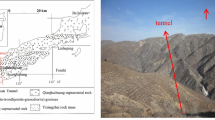Abstract
Tunneling in complicated geological conditions frequently encounters problems with squeezing ground, large ground deformation, rockbursts, asymmetric deformation, non-linear rheology of surrounding rock, water inrush, and failure of supporting structures. In this paper, the Sichuan–Tibet highway, which is located at the north-west edge of the Sichuan basin and the eastern margin of the Qinghai–Tibet plateau, serves as a case study to investigate potential hazard sources for tunnels constructed in complex and difficult mountainous areas. Consideration first is given to the following 5 sets of conditions: crossing a fault zone, shallow tunnels in soft rock, crossing a landslide deposit, and deep tunnels in hard and soft rock formations. A program of field tests was performed to study the changes in rock pressure and the performance of support structures in different geological conditions. The results confirmed that the squeezing of rock depended upon a combination of the surrounding rock strength and the in situ stress field; fracture zones and water conditions reduced the integrity and mechanical properties of the surrounding rocks; topography and bedding structure can induce asymmetric mechanical behavior of the supporting structures during construction. Meanwhile, time-dependent rock deformation may have greater adverse impacts on the structural safety performance of tunnel during their operation.



























Similar content being viewed by others
References
Barla G, Bonini M, Semeraro M (2011) Analysis of the behaviour of a yield-control support system in squeezing rock. Tunn Undergr Space Technol 26:146–154
Cao CY, Shi CH, Lei MF et al (2018) Squeezing failure of tunnels: a case study. Tunn Undergr Space Technol 77:188–203
Chen ZQ, He C, Wu D et al (2017) Fracture evolution and energy mechanism of deep-buried carbonaceous slate. Acta Geotech 12(6):1243–1260
Chen ZQ, He C, Xu GW et al (2019) Supporting mechanism and mechanical behavior of a double primary support method for tunnels in broken phyllite under high geo-stress: a case study. Bull Eng Geol Environ 78:5253–5267
Chen ZY, Shi C, Li TB, Yuan Y (2012) Damage characteristics and influence factors of mountain tunnels under strong earthquakes. Nat Hazards 61(2):387–401
Cui Z, Sheng Q, Leng X, Ma YL (2019) Investigation of the long-term strength of Jinping marble rocks with experimental and numerical approaches. Bull Eng Geol Environ 78(2):877–882
Feng XT, Xu H, Qiu SL et al (2018) In situ observation of rock spalling in the deep tunnels of the China Jinping underground laboratory (2400m depth). Rock Mech Rock Eng 51(4):1193–1213
Gao Y, Xu F, Zhang Q et al (2018) Geotechnical monitoring and analyses on the stability and health of large cross-section railway tunnel constructed in seismic area. Measurement 122:620–629
Hoek E, Guevara R (2009) Overcoming squeezing in the Yacambú-Quibor tunnel, Venezuela. Rock Mech Rock Eng 42(2):389–418
Huang RQ, Li WL (2014) Post-earthquake landsliding and long-term impacts in the Wenchuan earthquake area, China. Eng Geol 182:111–120
Huang RQ, Wang Z, Pei SP, Wang YS (2009) Crustal ductile flow and its contribution to tectonic stress in Southwest China. Tectonophysics 473(3):476–489
Khanlari G, Meybodi RG, Mokhtari E (2012) Engineering geological study of the second part of water supply Karaj to Tehran tunnel with emphasis on squeezing problems. Eng Geol 145–146:9–17
Li TB, Ma CC, Zhu ML et al (2017) Geomechanical types and mechanical analyses of rockbursts. Eng Geol 222:72–83
Liang DX, Jiang ZQ, Zhu SY et al (2016) Experimental research on water inrush in tunnel construction. Nat Hazards 81(1):467–480
Meng LB, Li TB, Jiang Y et al (2013) Characteristics and mechanics of large deformation in the Zhegu mountain tunnel on the Sichuan-Tibet highway. Tunn Undergr Space Technol 37(6):157–164
Ministry of Transport of PRC (2004) Code for Design of Road Tunnels. China Communication Publisher Ltd., Beijing
Shen YS, Gao B, Yang XM, Tao SJ (2014) Seismic damage mechanism and dynamic deformation characteristic analysis of mountain tunnel after Wenchuan earthquake. Eng Geol 180:85–98
Shi SS, Xie XK, Bu L et al (2018) Hazard-based evaluation model of water inrush disaster sources in karst tunnels and its engineering application. Environ Earth Sci 77(4):141
Wang TT (2010) Characterizing crack patterns on tunnel linings associated with shear deformation induced by instability of neighboring slopes. Eng Geol 115:80–95
Xiao JZ, Dai FC, Wei YQ et al (2014) Cracking mechanism of secondary lining for a shallow and asymmetrically-loaded tunnel in loose deposits. Tunn Undergr Space Technol 43(7):232–240
Xu GW, He C, Su A, Chen ZQ (2018) Experimental investigation of the anisotropic mechanical behavior of phyllite under triaxial compression. Int J Rock Mech Min Sci 104:100–112
Xu GW, He C, Wang Y, Wang B (2016) Study on the safety performance of cracked secondary lining under action of rheological load. Chin Civil Eng J 49(12):114–123 (in Chinese)
Yu HT, Chen JT, Bobet A, Yuan Y (2016) Damage observation and assessment of the Longxi tunnel during the Wenchuan earthquake. Tunn Undergr Space Technol 54:102–116
Zhang GH, Jiao YY, Wang H (2014) Outstanding issues in excavation of deep and long rock tunnels: a case study. Can Geotech J 51(9):984–994
Zhang N, Shen JS, Zhou AN, Arulrajah A (2018) Tunneling induced geohazards in mylonitic rock faults with rich groundwater: a case study in Guangzhou. Tunn Undergr Space Technol 74:262–272
Zhang ZQ, Chen FF, Li N et al (2017) Influence of fault on the surrounding rock stability of a tunnel: location and thickness. Tunn Undergr Space Technol 61(1):1–11
Zhao J, Feng XT, Zhang XW et al (2018) Brittle-ductile transition and failure mechanism of Jinping marble under true triaxial compression. Eng Geol 232:160–170
Acknowledgments
The insightful and constructive comments provided by the reviewers are greatly appreciated.
Funding
This research was supported by the National Key R&D Program of China (No. 2016YFC0802210) and High Speed Railway and Natural Science United Foundation of China (No. U1734205).
Author information
Authors and Affiliations
Corresponding author
Rights and permissions
About this article
Cite this article
Chen, Z., He, C., Yang, W. et al. Impacts of geological conditions on instability causes and mechanical behavior of large-scale tunnels: a case study from the Sichuan–Tibet highway, China. Bull Eng Geol Environ 79, 3667–3688 (2020). https://doi.org/10.1007/s10064-020-01796-w
Received:
Accepted:
Published:
Issue Date:
DOI: https://doi.org/10.1007/s10064-020-01796-w




